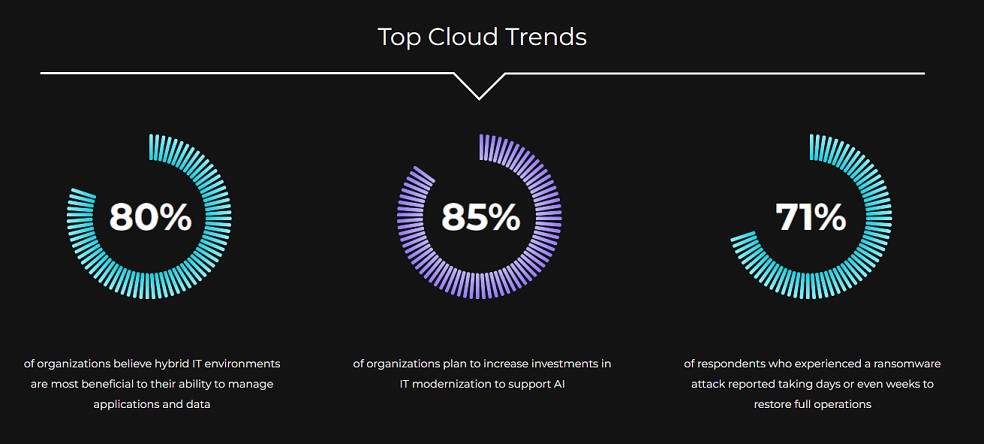The use of hybrid multicloud models is forecasted to double over the next one to three years as IT decision makers are facing new pressures to modernize IT infrastructures because of drivers like AI, security, and sustainability, according to the Enterprise Cloud Index (ECI) report from Nutanix.

Source: Nutanix
As organizations continue to grapple with the complexities of moving applications and data across environments, the report highlighted the growing importance of hybrid multicloud infrastructure. The report found that security and innovation were the top drivers for moving applications from one environment to another over the past year. As AI takes center stage for businesses, respondents identified increasing investments to support AI strategy as their #1 priority, followed closely by investment in IT modernization.
"Whether it be because of AI, sustainability, or security imperatives, IT organizations are facing ever-increasing pressure to modernize their IT infrastructure quickly," said Lee Caswell, SVP, Product and Solutions Marketing at Nutanix. "80% of ECI respondents are planning to invest in IT modernization, with 85% planning to increase their investments specifically to support AI. What this year's ECI reveals is that organizations need to support the technologies of tomorrow by future proofing their IT infrastructure today. Hybrid multicloud continues to emerge as the infrastructure standard of choice because of the flexibility it provides to support traditional VM and modern containerized applications and movement between clouds and on-prem."
Key findings from this year's report include:
Hybrid multicloud infrastructure deployments will become an infrastructure standard
90% of ECI respondents are taking a "cloud smart" approach to their infrastructure strategy — leveraging the best environment (e.g., data center, public cloud, edge) for each of their applications. Given the pervasiveness of this approach, it is no wonder that hybrid and multicloud environments have become the de facto infrastructure standard. Furthermore, over 80% of organizations believe hybrid IT environments are most beneficial to their ability to manage applications and data. Most importantly, this is now becoming an executive priority, with nearly half of respondents noting that implementing hybrid IT is a top priority for their CIO.
Ransomware protection is top of mind
Ransomware protection is top of mind for both CXOs and practitioners but most organizations continue to struggle in the wake of attacks. Ransomware and malware attacks will remain existential threats to modern enterprises, with the cat-and-mouse game between malicious actors and enterprise security professionals set to continue throughout 2024. Yet, data protection and recovery remain a challenge, as 71% of respondents who experienced a ransomware attack reported taking days or even weeks to restore full operations. To help address this, 78% of organizations say they plan to increase investments in ransomware protection solutions throughout this year.
Application and data movement remains a challenge
As organizations seek equilibrium driven by security and innovation, application and data movement remains a complex challenge. Enterprise workloads — including their applications and data — often find their way into the IT environment which best suits their needs, whether that environment is an on-premises data center, the public cloud, a smaller edge location, or a mix of all three.
This diversity of application placement is part of the reason why 95% of respondents say they moved applications from one environment to another over the past year, with security and innovation as the top drivers for this movement. Enterprises should expect application and data movement to remain constant, and plan infrastructure choices accordingly — emphasizing flexibility and visibility. Today, organizations face significant roadblocks when it comes to executing complex application migrations, with 35% of respondents saying workload and application migration is a significant challenge given their current IT infrastructure.
It teams are starting sustainability programs
IT teams aren't just planning their sustainability programs, they are actively implementing them starting with IT modernization. 88% of respondents agree that sustainability is a priority for their organization. However, unlike in the previous report where action was limited, many organizations indicate they are already taking active steps to implement sustainability initiatives, with the most common being modernizing IT infrastructure. This is a fascinating result, and one that shows the direct impact of IT infrastructure on sustainability.
Infrastructure modernization is becoming an imperative
Infrastructure modernization is becoming an imperative, driven by AI, modern applications and data growth. Respondents identified increased investment to support AI strategy as their #1 priority, followed closely by investment in IT modernization. Furthermore, 37% of respondents indicate running AI applications on their current IT infrastructure will be a "significant" challenge.
In order to mitigate and overcome this challenge, organizations are prioritizing IT modernization and edge infrastructure deployments, which can facilitate faster processing and access to data. This, in turn, can help improve their ability to link data from multiple environments to give better visibility into where data resides across their sprawling ecosystems
Methodology: Vanson Bourne conducted research on behalf of Nutanix, surveying 1,500 IT and DevOps/Platform Engineering decision-makers around the world in December 2023. The respondent base spanned multiple industries, business sizes, and geographies, including North and South America; Europe, the Middle East and Africa (EMEA); and Asia-Pacific-Japan (APJ) region.
